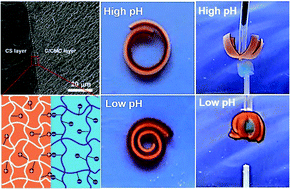Bilayer hydrogel actuators with tight interfacial adhesion fully constructed from natural polysaccharides†
Abstract
Smart hydrogel actuators with excellent biocompatibility and biodegradation are extremely desired for biomedical applications. Herein, we have constructed bio-hydrogel actuators inspired by the bilayer structures of plant organs from chitosan and cellulose/carboxymethylcellulose (CMC) solution in an alkali/urea aqueous system containing epichlorohydrin (ECH) as a crosslinker, and demonstrated tight adhesion between two layers through strong electrostatic attraction and chemical crosslinking. The bilayer hydrogels with excellent mechanical properties could carry out rapid, reversible, and repeated self-rolling deformation actuated by pH-triggered swelling/deswelling, and transformed into rings, tubules, and flower-, helix-, bamboo-, and wave-like shapes by effectively designing the geometric shape and size. The significant difference in the swelling behavior between the positively charged chitosan and the negatively charged cellulose/CMC layers generated enough force to actuate the performance of the hydrogels as soft grippers, smart encapsulators, and bioinspired lenses, showing potential applications in a wide range of fields including biomedicine, biomimetic machines, etc.


 Please wait while we load your content...
Please wait while we load your content...